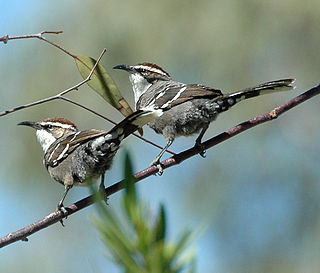 W
WThe Pomatostomidae are small to medium-sized birds endemic to Australia-New Guinea. For many years, the Australo-Papuan babblers were classified, rather uncertainly, with the Old World babblers (Timaliidae), on the grounds of similar appearance and habits. More recent research, however, indicates that they are too basal to belong the Passerida – let alone the Sylvioidea where the Old World babblers are placed – and they are now classed as a separate family close to the Orthonychidae (logrunners). Five species in one genus are currently recognised, although the red-breasted subspecies rubeculus of the grey-crowned babbler may prove to be a separate species.
 W
WThe Pomatostomidae are small to medium-sized birds endemic to Australia-New Guinea. For many years, the Australo-Papuan babblers were classified, rather uncertainly, with the Old World babblers (Timaliidae), on the grounds of similar appearance and habits. More recent research, however, indicates that they are too basal to belong the Passerida – let alone the Sylvioidea where the Old World babblers are placed – and they are now classed as a separate family close to the Orthonychidae (logrunners). Five species in one genus are currently recognised, although the red-breasted subspecies rubeculus of the grey-crowned babbler may prove to be a separate species.
 W
WThe chestnut-crowned babbler is a medium-sized bird that is endemic to arid and semi-arid areas of south-eastern Australia. It is a member of the family Pomatostomidae, which comprises five species of Australo-Papuan babblers. All are boisterous and highly social, living in groups of up to 23 individuals that forage and breed communally. Other names include red-capped babbler, rufous-crowned babbler and chatterer.
 W
WThe grey-crowned babbler is a species of bird in the family Pomatostomidae. It is found in Australia, Indonesia, and Papua New Guinea. Its natural habitats are temperate forests and subtropical or tropical moist lowland forests.
 W
WHall's babbler is a small species of bird in the family Pomatostomidae most commonly found in dry Acacia scrubland of interior regions of eastern Australia. Superficially similar to the white-browed babbler this species was only recognised during the 1960s, which makes it a comparatively recent discovery. The bird is named after the Australian-born philanthropist Major Harold Wesley Hall, who funded a series of expeditions to collect specimens for the British Museum, during which the first specimens of Hall's Babbler were collected in southwestern Queensland in 1963.
 W
WThe Papuan babbler, New Guinea babbler or Isidore's rufous babbler, is a species of bird in the family Pomatostomidae. It is found in New Guinea. Its natural habitat is subtropical or tropical moist lowland forests.
 W
WThe white-browed babbler is a small, gregarious species of bird in the family Pomatostomidae. They are endemic to the open woodlands and shrubby areas of central and southern Australia. The Latin name superciliosus refers to the supercilium or ‘eyebrow’, which is a feature synonymous with the pomatostomine babblers.